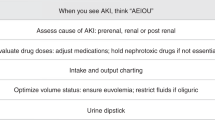Abstract
Background
Late recognition plays an important role in prognosis associated with kidney disease; thus, information transfer at hospital discharge regarding kidney disease is crucial. Whether it is notified in patients’ hospital discharge summary (HDS) is presently largely unknown.
Study design
Cross-sectional.
Setting and participants
The prevalence of kidney dysfunction [estimated glomerular filtration rate (eGFR) <60 ml/min/1.73 m2] and its reporting to primary-care physicians from 26 units [11 surgery, 11 medical, 4 intensive care units (ICUs)] of a university hospital were analyzed in 14,000 hospitalizations.
Predictor
eGFR.
Outcome
Notification of kidney dysfunction in HDS.
Measurements
GFR was estimated from serum creatinine using the Modification of Diet in Renal Disease formula.
Results
Kidney dysfunction was frequent (27.2 %) but infrequently notified in the main-body of the HDS (overall 25.3 %, medical 25 %, surgical 16.3 %, ICU 48.4 %) even when severe (eGFR 15–29.9 ml/min/1.73 m2 was notified in 68.8, 38.5, and 79.8 % of HDSs in medical, surgical and ICUs, respectively). Notification in the HDS conclusion was rare (overall 11.4 %, medical 9.8 %, surgical 8.4 %, ICU 27.5 %). Reporting remained low when eGFR remained abnormal at discharge (medical 35.8 %, surgical 22.5 %, ICU 62.2 %) but was worse for acute kidney injury (16.0, 17.1, and 37.7 %, respectively). The optimal eGFR cut-off for reporting was 39 ml/min/1.73 m2. Longer durations of hospitalization, greater numbers of creatinine measurements and of abnormal eGFR were associated with notification, regardless of the type of unit.
Limitations
Lack of data to define acute or chronic kidney injury with precision.
Conclusions
Kidney dysfunction is frequent in hospitalized patients but is usually not notified, even when severe or still present at discharge, suggesting that it is not considered important to disclose to primary-care physicians. This lack of information may decrease physicians’ awareness, and may affect continuity of care in patients with kidney dysfunction.


Similar content being viewed by others
References
Kripalani SLF (2007) Deficits in communication and information transfer between hospital-based and primary care physicians: implications for patient safety and continuity of care. JAMA 297(8):831–841
Wang HE, Muntner P, Chertow GM, Warnock DG (2012) Acute kidney injury and mortality in hospitalized patients. Am J Nephrol 35(4):349–355
Coca SG, Singanamala S, Parikh CR (2012) Chronic kidney disease after acute kidney injury: a systematic review and meta-analysis. Kidney Int 81(5):442–448
James MT, Hemmelgarn BR, Tonelli M (2010) Early recognition and prevention of chronic kidney disease. Lancet 375(9722):1296–1309
Go AS, Chertow GM, Fan D, McCulloch CE, Hsu C (2004) Chronic kidney disease and the risks of death, cardiovascular events, and hospitalization. N Engl J Med 351(13):1296–1305
Stevens LA, Fares G, Fleming J, Martin D, Murthy K, Stark PC, Uhlig K, Van Lente F, Levey AS (2005) Low rates of testing and diagnostic codes usage in a commercial clinical laboratory: evidence for lack of physician awareness of chronic kidney disease. J Am Soc Nephrol 16(8):2439–2448
Jungers P (2002) Late referral: loss of chance for the patient, loss of money for society. Nephrol Dial Transplant 17(3):371–375
Chan MR, Dall AT, Fletcher KE, Lu N, Trivedi H (2007) Outcomes in patients with chronic kidney disease referred late to nephrologists: a meta-analysis. Am J Med 120(12):1063–1070
Smart NA, Titus TT (2011) Outcomes of early versus late nephrology referral in chronic kidney disease: a systematic review. Am J Med 124(11):1073–1080.e2
Levey AS, Coresh J (2012) Chronic kidney disease. Lancet 379(9811):165–180
Kim DH, Kim M, Kim H, Kim YL, Kang CW, Kim NH, Kim YS, Lee JP (2013) Early referral to a nephrologist improved patient survival: prospective cohort study for end-stage renal disease in Korea. PLoS ONE 8(1):e55323
Palevsky PM, Liu KD, Brophy PD, Chawla LS, Parikh CR, Thakar CV, Tolwani AJ, Waikar SS, Weisbord SD (2013) KDOQI US commentary on the 2012 KDIGO clinical practice guideline for acute kidney injury. Am J Kidney Dis 61(5):649–672
Rothberg MB, Kehoe ED, Courtemanche AL, Kenosi T, Pekow PS, Brennan MJ, Mulhern JG, Braden GL (2008) Recognition and management of chronic kidney disease in an elderly ambulatory population. J Gen Intern Med 23(8):1125–1130
Gentile G, Postorino M, Mooring RD, De Angelis L, Manfreda VM, Ruffini F, Pioppo M, Quintaliani G (2009) Estimated GFR reporting is not sufficient to allow detection of chronic kidney disease in an Italian regional hospital. BMC Nephrol 10:24
Guessous I, McClellan W, Vupputuri S, Wasse H (2009) Low documentation of chronic kidney disease among high-risk patients in a managed care population: a retrospective cohort study. BMC Nephrol 10:25
National Kidney Foundation (2002) K/DOQI clinical practice guidelines for chronic kidney disease: evaluation, classification, and stratification. Am J Kidney Dis 39(Suppl 1):S1–S266
Hemmelgarn BR, Zhang J (2010) Nephrology visits and health care resource use before and after reporting estimated glomerular filtration rate. JAMA 303(12):1151–1158
Akbari A, Grimshaw J, Stacey D, Hogg W, Ramsay T, Cheng-Fitzpatrick M, Magner P, Bell R, Karpinski J (2012) Change in appropriate referrals to nephrologists after the introduction of automatic reporting of the estimated glomerular filtration rate. CMAJ 184(5):E269–E276
Akbari ASP (2004) Detection of chronic kidney disease with laboratory reporting of estimated glomerular filtration rate and an educational program. Arch Intern Med 164(16):1788–1792
Poggio ED, Nef PC, Wang X, Greene T, Van Lente F, Dennis VW, Hall PM (2005) Performance of the Cockcroft–Gault and modification of diet in renal disease equations in estimating GFR in ill hospitalized patients. Am J Kidney Dis 46(2):242–252
Conflict of interest
The authors declare that they have no conflict of interest.
Ethical standard
For this type of study formal consent is not required.
Author information
Authors and Affiliations
Corresponding author
Rights and permissions
About this article
Cite this article
Sautenet, B., Caille, A., Giraudeau, B. et al. Deficits in information transfer between hospital-based and primary-care physicians, the case of kidney disease: a cross-sectional study. J Nephrol 28, 563–570 (2015). https://doi.org/10.1007/s40620-015-0175-3
Received:
Accepted:
Published:
Issue Date:
DOI: https://doi.org/10.1007/s40620-015-0175-3




